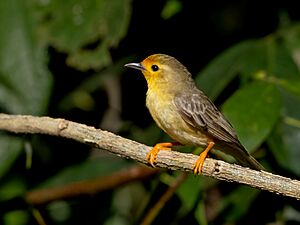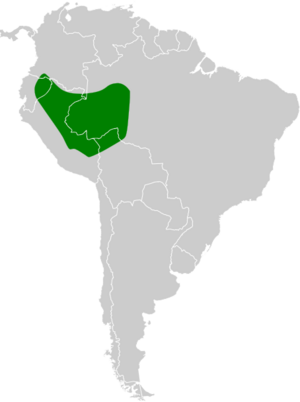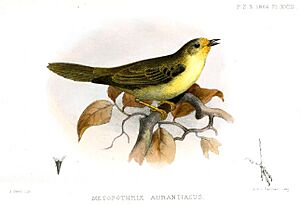Orange-fronted plushcrown facts for kids
Quick facts for kids Orange-fronted plushcrown |
|
|---|---|
 |
|
| Conservation status | |
| Scientific classification | |
| Genus: |
Metopothrix
|
| Species: |
aurantiaca
|
 |
|
The orange-fronted plushcrown (Metopothrix aurantiaca) is a small, colorful bird. It belongs to the ovenbird family, called Furnariidae. You can find this special bird in parts of Bolivia, Brazil, Colombia, Ecuador, and Peru.
Contents
About the Orange-fronted Plushcrown
The orange-fronted plushcrown is quite unique! It's the only bird in its group, called a genus. This means it doesn't have any close relatives that look exactly like it. Scientists once wondered if it truly belonged to the ovenbird family. This was because its feathers look very different from most other ovenbirds. But special genetic tests have shown that it really is part of that family.
What Does the Orange-fronted Plushcrown Look Like?
This little bird is about 11 to 12 centimeters (4 to 5 inches) long. It weighs around 10 to 12 grams (0.35 to 0.42 ounces). Both male and female birds look the same.
They have a bright orange forehead, which is why they are called "orange-fronted." Their face also has yellow around their eyes and above them. A faint green line goes through their eye. The feathers covering their ears are greenish-olive.
Their back, rump, and tail are also greenish-olive. Their wings are dark olive with pale yellow edges. Their throat is yellow. The rest of their belly is a dull yellowish-green. Their eyes are brown, and their beak is black or gray. Their legs and feet are a bright yellow-orange. Young birds have less orange and yellow on their faces. This bird is special because it's the only ovenbird with yellow-green feathers and yellow legs. It looks a bit like a tanager or a warbler.
Where Does the Orange-fronted Plushcrown Live?
You can find the orange-fronted plushcrown in several South American countries. These include southeastern Colombia, eastern Ecuador, eastern Peru, northeastern Bolivia, and western Brazil. It lives in forests right next to rivers. It also likes islands within rivers and older re-grown forests. Sometimes, it can be seen at the edges of clearings. This bird prefers várzea (flooded forests) and terra firme (dry land) forests. It usually stays close to a river. These birds are typically found at elevations from 150 to 650 meters (490 to 2,130 feet) above sea level.
How Does the Orange-fronted Plushcrown Behave?
Movement
The orange-fronted plushcrown stays in the same area all year long. It does not migrate.
Feeding Habits
This bird mainly eats arthropods, like insects and spiders. It has also been seen eating fruit once. Orange-fronted plushcrowns usually look for food in pairs or small family groups. Sometimes, they join other bird species in mixed feeding flocks. They search for food from the middle to the top of the forest trees. They often hang upside down to pick prey from leaves and small branches.
Reproduction and Nests
Scientists don't know much about when these birds breed. However, they seem to start building nests in January. Their nest is a big ball made of sticks. It has an entrance on the side. They build these nests in trees, usually between 4 and 20 meters (13 and 65 feet) off the ground. Not much else is known about how they raise their young.
Sounds and Calls
The orange-fronted plushcrown's song is a series of three to five high, thin notes that go down in pitch. Its call is a thin "tsweet-tsweet" sound.
What is the Orange-fronted Plushcrown's Status?
The IUCN (International Union for Conservation of Nature) has listed the orange-fronted plushcrown as a species of "Least Concern." This means it is not currently considered to be in danger of extinction. It lives across a very large area. Even though its exact population size isn't known, scientists believe it is stable. There are no major threats to this bird right now. It is generally uncommon, but in some places, it can be found quite often. It also lives in several protected areas. Some scientists think that a little bit of forest clearing might even help this bird. This is because it likes the edges of forests, which can increase with some deforestation.



